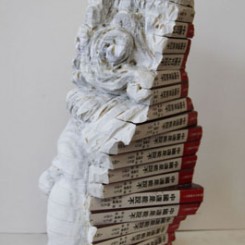“Do A Book,” group exhibition, curated by Katherine Don and George Chang.
White Space Beijing (No.255 Caochangdi, Airport Service Road, Chaoyang District, Beijing). Feb 18–Mar 18, 2012.
“The art of the book” / books-as-art / artists’ books / “bookworks” / book-objects…. The realm loosely bounded by these terms is characteristically amorphous. Book art’s aura of intrigue and charm hinges on the intimacy associated with reading, combined with the nebulous potential of “art” and all this conjures for the individual mind. Objects, artworks, books: hybrid vessels of the unexpected that hover between reading, seeing, writing and making. Book art’s Western history can be charted from early beginnings with William Blake’s illuminated books, for example; at the turn of the 20th Century, “livres d’artiste” were endorsed by the inspired dealer Ambroise Vollard, who commissioned limited editions illustrated by artists. What has come to be understood less as a medium than a “genre” was expanded later by Dieter Roth and Ed Ruscha, whose conceptual approaches in the 1950s and 60s cemented the will to explore, manipulate and deconstruct the book form in an artistic vein.
But what about China? Certainly no such clear history exists here, though an accord between books and art can’t be denied. In 2006-2007, “Shu: Reinventing Books in Chinese Contemporary Art,” a two-part show curated by Wu Hung at the China Institute drew attention to works born of artists’ responses to the socio-political relationship with literary culture in China. There were featured such things as Xu Bing’s infamous “Book From the Sky” (1987-1991), as well as Zhang Xiaogang’s 1991 Private Notes series — paintings showing the artist’s body becoming dismembered in the face of difficulties with letters and manuscripts. But although powerful, these pieces don’t relate to some of book art’s usual tenets as shaped by its 20th-century Western history — intimacy, small scale, and direct attention to the physical notion of a book.
So, why “Do A Book” in Beijing this year? Co-curated by Katherine Don and George Chang, this exhibition at White Space brought us 25 artists’ unique book art pieces. “That’s actually all we said,” Don remarked, “Some of the artists were very liberal and extracted a part of it, and it’s interesting how the works are born of a notebook, to newspaper, to ceramics, to actual books that have been published before.” True, here was Ma Jun’s impenetrable porcelain version of the Communist Manifesto and a folio of “Hair Sketches” by Tom Bell — the cover a glossy black mass and each page featuring an “abstract portrait” made from a lock of hair; Sarah Sze’s “Notepad” laser-etched a block of pages into sculptural undulations hung on the wall. “It’s not as if it’s very novel and we had to force artists to do something,” she says, “All artists are doing artists’ books or something related to book art…. The most prominent response was that they would show us their work and say ‘this is my art but this is something I do on the side.’”
The need was therefore not to convince the artists: “We’ve had so many offers on Weibo like ‘Hey, I have a book, you wanna see my book?!’” Don says — but rather to reach an audience. Motivated ostensibly by the curators’ personal interest (“What we really wanted to call attention to is that these works are out there…. I’m pretty sure this is the first exhibition of its kind”… It’s like “what about that?!”), “Do a Book” went down very well, we hear. Ironically, the electronic channels that are murdering the printed word were what animated the discussion: “Weibo was going nuts” apparently, with about 100 “re-tweets” every hour on the opening day. Curators take note: “The gallery, as we were installing, put up all the images-in-process and details of the works.”
It seems the exhibition also threw some light on the relationship with books, on their treatment as representative objects (Ma Jun’s porcelain piece was an unopenable, sealed weight, and the Austrian artist Emma Walner used Mao Zedong’s Selected Works — which of course she had never read), and their tenacity, as Don claims that at the same time, “all these artists do is read.” Xu Lei was one artist to tweet a response to the show wherein he said he really liked small things, and that this was a refreshing show to engage with specific objects. For Don, “That was our goal and is what I love about paper: it draws you in as opposed to pushing you back and forcing you to look at it in its entirety. The intimacy of the objects is something that I like. It’s a lot harder to create small works than it is to create big works.”
For the 1000-or-so people who visited “Do A Book” on the opening day, or later on, or cheeped online about it, then, this was an exhibition worth the trip/click. Don “really wasn’t sure if the audience would get into it — or even be immediately responsive about it….It’s not a line-up of who’s who — it’s a line-up of who’s doing what.” It would seem that China is doing book art, and perhaps — as of now — book art exhibitions. Whatever next?
